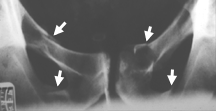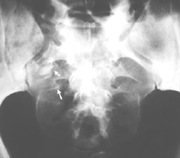
Answers Back to contents

The obturator ring fractures appear as cortical discontinuities as well as areas of increased density where the bone fragments are overriding.
Did you notice the vertical fracture of the right sacrum? It is a bit subtle, but then, most sacral fractures are. The best way to consistently identify them is to look carefully at the transverse sacral foraminal lines in every patient. Note the appearance of these lines on the normal left side. We don't see smooth, continuous curves like this on the right side. Instead, we see discontinuities and even a bony fragment.

A good rule to apply in the pelvis is the ring bone rule. The general form of this rule is:
In a ring bone or ring bone-equivalent, if you see a fracture or dislocation in one part of that bone, look for another one.
To get a feeling for why this might be so, go buy a bag of pretzels and try to break a pretzel in only one place. If you manage to do this, please don't send e-mail about it -- it's been done before. The main thing is that it is difficult to do. It is very hard to apply just enough force to break one part of the ring without also going on to break another part of the ring.
What are some of the ring bones? Obviously the obturator rings of the pelvis count as ring bones. The whole pelvis forms yet another, larger ring. Each of the sets of ribs form a ring with the sternum and spine. Each vertebra has a ring (also known as the spinal canal). The mandible and skull form a ring system, and the zygomatic arch is also considered a ring bone. One could also count the transverse foramina in each of the cervical vertebrae.
What is a ring bone-equivalent? It is a bone that acts like a ring bone, even though it may not be round. The radius and ulna together act like a ring bone, as do the tibia and fibula.
There are two corollaries to the ring bone rule that can be very useful:
The first is what Dr. Lee Rogers calls "the pretzel-bagel spectrum". Some ring bones, like the obturator rings are fairly stiff. This means that the obturator ring will almost always fracture in two places when fractured. At the other end of the spectrum are bones that form very flexible rings, such as the ribs. In floppy, more flexible rings like this, it is very common to see only one fracture in the ring.
The second corollary applies to the pelvis. If one draws a horizontal line between both acetabulae, one can use it to divide the pelvis up into an anterior and a posterior portion of the pelvis. The corollary is that if there is a fracture or dislocation in the anterior part of the ring, look for one in the posterior part as well.
These rules tell us to look for two fractures in the greater pelvic ring, which we see in each of the superior rami of the obturator rings. The rule also tells us to expect at last two fractures in each. Therefore, the ring bone tells us to look carefully all the way around each of the obturator rings, which allows us to spot the two fractures in each of these rings.
Since we see fractures in the anterior portion of the pelvis, we must look very carefully in posterior portion, especially the sacrum. A close inspection of the transverse sacral foraminal lines reveals the transforaminal fracture there.